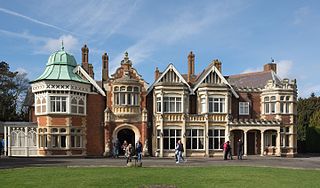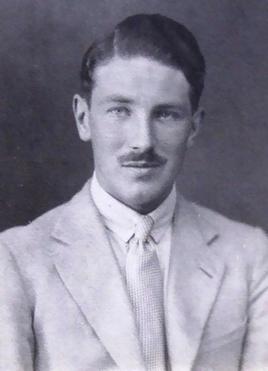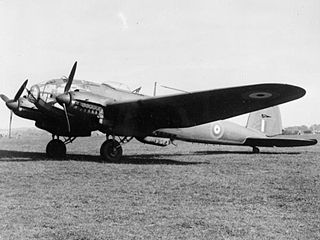
Bletchley Park is an English country house and estate in Bletchley, Milton Keynes (Buckinghamshire) that became the principal centre of Allied code-breaking during the Second World War. The mansion was constructed during the years following 1883 for the financier and politician Herbert Leon in the Victorian Gothic, Tudor and Dutch Baroque styles, on the site of older buildings of the same name.

Ultra was the designation adopted by British military intelligence in June 1941 for wartime signals intelligence obtained by breaking high-level encrypted enemy radio and teleprinter communications at the Government Code and Cypher School (GC&CS) at Bletchley Park. Ultra eventually became the standard designation among the western Allies for all such intelligence. The name arose because the intelligence obtained was considered more important than that designated by the highest British security classification then used and so was regarded as being Ultra Secret. Several other cryptonyms had been used for such intelligence.

Fish was the UK's GC&CS Bletchley Park codename for any of several German teleprinter stream ciphers used during World War II. Enciphered teleprinter traffic was used between German High Command and Army Group commanders in the field, so its intelligence value (Ultra) was of the highest strategic value to the Allies. This traffic normally passed over landlines, but as German forces extended their geographic reach beyond western Europe, they had to resort to wireless transmission.
The Cipher Bureau was the interwar Polish General Staff's Second Department's unit charged with SIGINT and both cryptography and cryptanalysis.
Cryptanalysis of the Enigma ciphering system enabled the western Allies in World War II to read substantial amounts of Morse-coded radio communications of the Axis powers that had been enciphered using Enigma machines. This yielded military intelligence which, along with that from other decrypted Axis radio and teleprinter transmissions, was given the codename Ultra.
Cryptography was used extensively during World War II because of the importance of radio communication and the ease of radio interception. The nations involved fielded a plethora of code and cipher systems, many of the latter using rotor machines. As a result, the theoretical and practical aspects of cryptanalysis, or codebreaking, were much advanced.

Enigma is a 2001 espionage thriller film directed by Michael Apted from a screenplay by Tom Stoppard. The script was adapted from the 1995 novel Enigma by Robert Harris, about the Enigma codebreakers of Bletchley Park in the Second World War.

William Gordon Welchman OBE was a British mathematician. During World War II, he worked at Britain's secret decryption centre at Bletchley Park, where he was one of the most important contributors.

Operation Ruthless was the name of a deception operation devised by Ian Fleming in the British Admiralty during World War II, in an attempt to gain access to German Naval Enigma codebooks.

A cryptogam is a plant or a plant-like organism that reproduces by spores, without flowers or seeds. The name Cryptogamae means "hidden reproduction", referring to the fact that no seed is produced, thus cryptogams represent the non-seed bearing plants. Other names, such as "thallophytes", "lower plants", and "spore plants" are also occasionally used. As a group, Cryptogamae are the opposite of the Phanerogamae or Spermatophyta, the seed plants. The best-known groups of cryptogams are algae, lichens, mosses, and ferns, but it also includes non-photosynthetic organisms traditionally classified as plants, such as fungi, slime molds, and bacteria. The classification is now deprecated in Linnaean taxonomy. Cryptogams have been classified into three sub-kingdoms: Thallophyta (thallophyte), Bryophyta (bryophyte), and Pteridophya (pteridophyte).

Hut 6 was a wartime section of the Government Code and Cypher School (GC&CS) at Bletchley Park, Buckinghamshire, Britain, tasked with the solution of German Army and Air Force Enigma machine cyphers. Hut 8, by contrast, attacked Naval Enigma. Hut 6 was established at the initiative of Gordon Welchman, and was run initially by Welchman and fellow Cambridge mathematician John Jeffreys.
John William Jamieson Herivel was a British science historian and World War II codebreaker at Bletchley Park.
The Testery was a section at Bletchley Park, the British codebreaking station during World War II. It was set up in July 1942 as the "FISH Subsection" under Major Ralph Tester, hence its alternative name. Four founder members were Tester himself and three senior cryptanalysts were Captain Jerry Roberts, Captain Peter Ericsson and Major Denis Oswald. All four were fluent in German. From 1 July 1942 on, this team switched and was tasked with breaking the German High Command's most top-level code Tunny after Bill Tutte successfully broke Tunny system in Spring 1942.
Mavis Lilian Batey, MBE, was a British code-breaker during World War II. She was one of the leading female codebreakers at Bletchley Park.
Mair Russell-Jones, born Mair Eluned Thomas, was a graduate in Music and German from Cardiff University who during the Second World War worked as a civilian codebreaker for the Government Code and Cypher School at Bletchley Park. She worked in Hut 6, decrypting messages in Enigma machine cipher.

About 7,500 women worked in Bletchley Park, the central site for British cryptanalysts during World War II. Women constituted roughly 75% of the workforce there. While women were overwhelmingly under-represented in high-level work such as cryptanalysis, they were employed in large numbers in other important areas, including as operators of cryptographic and communications machinery, translators of Axis documents, traffic analysts, clerical workers, and more. Women made up the majority of Bletchley Park’s workforce, most enlisted in the Women’s Royal Naval Service, WRNS, nicknamed the Wrens.
Ruth June Bourne was one of the Women of Bletchley Park who was recruited to help win World War II against the Axis Powers from 1939–1945. The Women of Bletchley Park were a secret team put together by the British government who were made to sign a Secrets Act confirming that they would not tell anyone about their work there. During her time at Bletchley, Ruth Bourne's job was not only to work on decrypting the German code system, but also to be a bombe operator. She was one of the Women's Royal Naval Service (WRENs) responsible for dismantling the bombes wire by wire after the war ended in 1945.

Ailsa Maxwell was a British Bletchley Park code breaker and historian.
Action This Day was a 1941 memorandum sent to Winston Churchill personally, to advise Churchill that the Bletchley Park (BP) codebreaking establishment was short of staff in some critical areas. Their requirements were small, but as a small organisation their management did not have priority. Four senior heads of sections ("Huts") and their deputies wrote to Churchill, who had visited "BP" on 6 September 1941, where he made a speech saying he appreciated their work.









